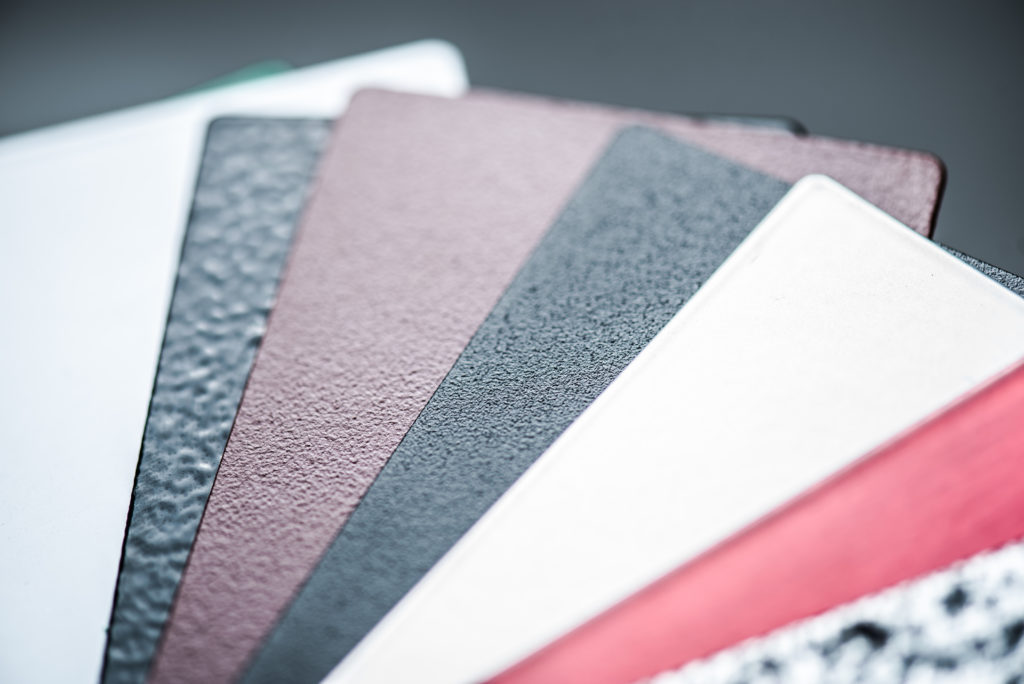
Powder coating is a dry finishing process in which free-flowing, thermoplastic, or thermoset powder material, rather than a liquid suspension, is applied to a surface, melted, and then allowed to dry and harden into a protective coating. Typically, the powder is applied via electrostatic spray deposition (ESD) to an electrically grounded metal substrate. Once the powder coating is completely applied to a part, it is then heat cured in an oven until the powder melts and flows together. Powder coatings can also be applied by dipping preheated parts into powder material within a fluidized bed. The powder melts and fuses with the part’s heated surface upon contact. In either case, as the part dries and cools, the cured powder forms a smooth, hard finish.
Powder coating can provide both functional and decorative surface coatings in a wide range of colors, styles, finishes, and textures that are not easily achievable by conventional liquid coating methods. Powder coatings are also comparatively durable, cost-effective, and environmentally friendly. However, they may not be suitable for all manufacturing applications, such as for low-budget, thin-film, or large part coating applications.
This article focuses on powder coating. It explores the benefits of the powder coating process and provides comparisons between the powder coating and liquid coating methods.
Advantages and Benefits of Powder Coating
Compared to conventional liquid coating methods, there are several advantages and benefits of powder coating. These include:
- More durable coatings
- Less environmental impact
- More efficient curing and drying processes
Durability
The powder coating process produces a long-lasting and durable, hard finish that is both protective and decorative. Demonstrating more resistance to impact, moisture, chemicals, and extreme weather than most liquid coatings of similar thickness, powder coatings offer a part or product greater protection from scratches, chipping, abrasions, corrosion, fading, and general wear. They can also act as electrical insulators and can withstand hundreds of hours of salt spray contact. For colored powder coatings, even after being subjected to extreme environments, the color remains brilliant and vibrant. This durability makes powder coatings well-suited for abrasive, high traffic, or high use areas, as well as diminishes the need for future coating touch-ups or replacement.
Environmental Impact
With contemporary social and legal attitudes towards ecological awareness, pollution control is an increasing concern in all areas of manufacturing. For example, manufacturers are usually required to file for permits and follow strict environmental regulations on the amount of solvent and volatile organic compounds (VOCs) emitted into the atmosphere or else face penalties and fines. The use of powder coatings offers an alternative that minimizes the amount of air pollution control equipment required while facilitating compliance with these regulations and restrictions.
Compared to liquid coatings, powder coatings do not require solvents to maintain the coating suspension. Solvents contain VOCs which are detrimental to the environment. In liquid coatings, the average VOC content is between 3.5 to 5.5 pounds per gallon, which translates to approximately one-third to one-half of each gallon of the liquid coating being emitted into the environment and atmosphere during the application process. Since powder coatings do not contain any solvents, they emit little to no VOCs throughout the finishing process.
Curing and Drying Process
Compared to liquid coatings, powder coatings require much shorter curing, processing, and drying times. Liquid coatings generally require several hours without heat, and forty-five minutes to an hour with the use of heat, before they are sufficiently cured to be handled in assembly operations. Once assembled, the coated parts are usually left to dry completely overnight before being packaged for shipment. Powder coatings, on the other hand, can be fully cured, on average, in ten minutes. Once cooled enough to handle, the part can be assembled and then packaged immediately. This further decreases the production time for a completed product or assembly, as well as reduces the number of parts that are left in staging areas to be assembled, packaged, or shipped.
Decorative Powder Coat Range Hoods
RangeCraft makes modern-theme powder-coated range hoods that are guaranteed to please. Each Rangecraft range hood is made one at a time, with superior craftsmanship to the highest quality standards. At RangeCraft, we specialize in individual orders, either standard designs or creating custom-made range hoods to your design ideas. RangeCraft range hoods are Made in America by trained artisans in our own factory here in New Jersey.
We want to help you complete your kitchen remodel with a truly one-of-a-kind range hood ventilation system, so please give us a call or submit your information on our online form to get started today!
